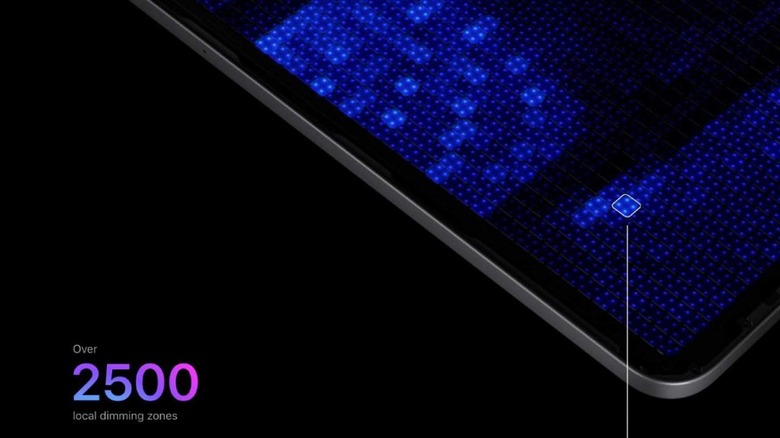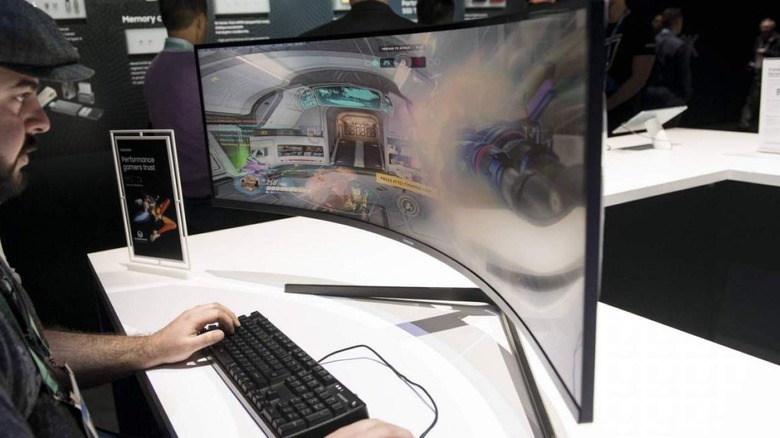Everything You Need To Know About Mini LED
We may receive a commission on purchases made from links.
Apple introduced its latest 12.9-inch iPad Pro model with the M1 chip in 2020. More recently, on its latest 14- and 16-inch MacBook Pro models, the term Mini LED has been bandied around quite a bit. Interestingly, as is often the case, Apple wasn't the first to market with this tech — that title goes to MSI with its Creator 17 laptop, which launched with a Mini LED display in May 2020. However, as is also often the case when Apple launches a new product with a new feature, the consumer electronics and mainstream media tend to amplify it, bringing wider attention.
Mini LED isn't an entirely new technology. STouchLighting notes that LED (light-emitting diode) technology has been around for many years and is typically found in LCD (liquid crystal display) panels. LCD panels can be found far and wide, from smartphones to computer monitors, TVs, and elsewhere. LCD TVs are usually composed of several layers, one of which includes a white-light-producing LED backlighting layer.
This is what gives LCD TVs their brightness, with the light emitted from the LED layer passing from behind the LCD layer and through. The only major drawback of this approach is that when the white light passes through areas of the image that are black, it washes out the pure blackness of the image. This can affect contrast and sharpness.
Mini LEDs provide increased backlighting control
Better contrast between blacks and colors creates more vivid images, so LCD TV makers have been searching for ways to overcome the shortcomings of traditional LED-backlit LCD displays, CNET explains. This became more urgent with the arrival of OLED TVs, which produce perfect blacks because they use a self-lit pixel technology that does not require backlighting.
LCD TV makers countered with what is called 'local dimming' technology that uses algorithms to detect what areas of the image should be darker than others, to improve the contrast between blacks and colors. This was an improvement but could result in an effect called "blooming," where light from brighter areas of an image bleeds into adjacent darker areas.
The Mini LEDs in Apple's iPad Pro are around 120x smaller than before, The Verge notes. This results in many more LEDs distributed across the same area, which gives much greater control over local area dimming than regular LEDs. As an example, the 12.9-inch iPad Pro has over 10,000 Mini LEDs spread across 2,500 local dimming zones.
As a result, blooming effects are reduced and contrast is further improved thanks to the increased number of dimming zones. In non-Mini LED iPads, the black bars at the top and bottom of movies look washed out, affecting the sharpness and contrast of the movie. This is all but eliminated in the new Mini LED iPad Pro models, according to The Verge.
Wrap-up
Mini LEDs are a genuine step forward for LCD panels with the benefits so far being seen in tablets, laptops, TVs, and monitors. Samsung, for example, debuted its first Mini LED-backlit Quantum Dot LCD monitors, via the company's website, which it markets as the Odyssey Neo G9 and Odyssey Neo G8 QLED gaming monitors. While Mini LED LCD displays still may not quite match the true blacks produced by OLED, LCD panels have a longer lifespan and generally deliver brightness levels that OLED panels can't replicate.
This makes the arrival of Mini LED technology something to be excited about. At the moment, devices featuring LCD panels with Mini LED technology tend to be a little pricier than traditional LED-backlit LCDs. At least now that you know what to look out for, you can be the judge as to whether you think paying the extra money is worth the step up in visual quality. We certainly think it is.


